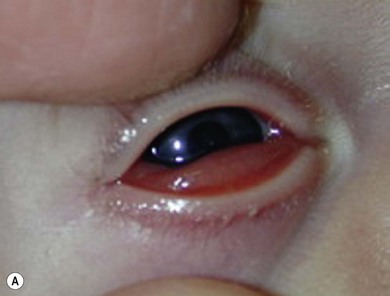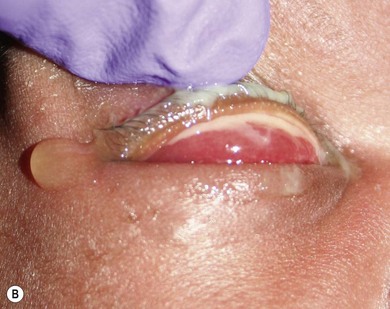Chapter 12 Neonatal conjunctivitis (ophthalmia neonatorum)
Neonatal conjunctivitis is the most common infection in the first month of life, with an incidence from 1% to 24%.1
Prophylaxis
Credé first reported the use of ocular prophylaxis for ophthalmia neonatorum; application of silver nitrate to the eyes of newborns decreased the incidence of ophthalmia neonatorum from 7.8% to 0.17%.2 Prior to the widespread use of prophylaxis, ophthalmia neonatorum was a common diagnosis in schools for the blind.2 Corneal scarring, including that caused by ophthalmia neonatorum, remains the leading cause of childhood blindness in Africa.3
Types of prophylaxis include: silver nitrate 1%, povidone iodine 2.5%, erythromycin ointment 0.5%, and tetracycline ointment 1%. These agents are administered to the inferior conjunctival fornix of both eyes within 1 hour of an infant’s delivery. Silver nitrate is most likely among the prophylactic agents to cause chemical conjunctivitis. Silver nitrate and tetracycline have equal 83−93% efficacy in the prevention of gonococcal ophthalmia neonatorum.4 In a controlled trial of 3117 Kenyan newborns, povidone iodine 2.5% was more effective than erythromycin or silver nitrate for prophylaxis of infectious conjunctivitis.5 However, in a randomized controlled trial involving 410 Israeli newborns, povidone iodine was marginally less effective in preventing infectious conjunctivitis and more likely to cause chemical conjunctivitis compared to tetracycline.6
In the United States, erythromycin 0.5% is used as the topical prophylactic agent. The other agents are not commercially available there. During an erythromycin shortage in 2009, the Centers for Disease Control recommended topical azithromycin 1% solution, or, if unavailable, topical gentamicin 0.3% or tobramycin 0.3% ointments. Azithromycin is approximately 10 times more costly than povidone iodine prepared by a hospital pharmacy.7 Topical gentamicin can cause periocular ulcerative dermatitis.8
Chlamydial conjunctivitis
The prevalence of Chlamydia trachomatis among pregnant women ranges from 2% to 20%; the higher rates are among younger women, and those without prenatal care.9 The likelihood that an infant born to a mother with untreated C. trachomatis infection develops symptomatic conjunctivitis ranges from 20% to 50%.4,10
Chlamydial conjunctivitis (Fig. 12.1A) typically develops 5−14 days after delivery. Though more common among infants born vaginally, it can occur after cesarean section delivery. The conjunctivitis is unilateral or bilateral, and the discharge is mucopurulent. Pseudomembrane formation can occur. Untreated, the conjunctivitis resolves after weeks to months, but can cause conjunctival and corneal scarring.






